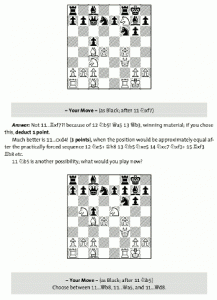Stimulus to Learning
by Michael McGuerty
Test Your Chess, by Zenon Franco, Everyman Chess 2014, Paperback, Figurine Algebraic Notation, 478pp. $29.95 (ChessCafe.com Price $25.51)
Zenon Franco is a grandmaster and chess trainer from Paraguay who now lives in Spain. He has represented Paraguay in seven Olympiads on top board, and twice won individual gold medals, at Lucerne in 1982 and Novi Sad in 1990. His most notable pupil is Francisco Vallejo Pons whom he trained from 1995 to 1999. In Test Your Chess Franco presents forty deeply annotated games in a test-yourself format similar to his book Chess Self-Improvement. American readers may be more familiar with the format through Bruce Pandolfini’s “Solitaire Chess” columns in Chess Life magazine.
The book is divided into four parts: the main theme of the eleven games in part one is an attack on the enemy king; part two, presents twelve games revolving around defense and counterattack; part three is comprised of twelve games where the main theme is positional play and pawn structure; and the focus of the five games in part four is on the endgame. Thereby readers are tested in all aspects of chess play: attack, counterattack, defense, endgames, strategy, and tactics, etc.
The content is divided as follows:
- Bibliography
- Introduction
- Attacking the King
- Attack, Defence and Counter-attack
- Positional Play and Typical Structures
- Endings
- Index of Games
- Index of Openings

The format is designed to help any aspiring player improve their chess. During each lesson you are designated to play the game as either white or black. The first few moves of the game are provided, anywhere from four to fifteen initial moves, and then the reader is challenged to assume the role of one of the players. The reader is encouraged to set up the pieces on a board and “play” as if it were a real game and to spend up to two hours on each lesson.

At critical junctures throughout the game you will be asked to determine the next move. Points are awarded or deducted based on the correctness of your answer. At the end of the game there is a point scale to indicate how well you did.
For example, here is the scale for Game Two:
(Maximum score: 45 points)
More than 39 points: Super-Grandmaster.
Between 35 and 39 points: Grandmaster.
Between 29 and 34 points: International Master.
Between 21 and 28 points: You play almost like Tal!
Between 10 and 20 points: You found several key attacking moves.
Less than 10 points: You must keep trying.
The maximum score is different for each game, while the top three scoring designations are the same throughout the book, but the bottom three differ from game to game. Franco notes that “especially younger [students] ascribe great importance to the scoring” and that they “really sit up and take notice, with improved concentration” when they are told that a move can gain points. He calls it “a stimulus to learning.”
Sometimes you are asked to decide upon moves for your opponent, since taking the plans for the opposing side into consideration is an important part of the game.
![[FEN "r1b2rk1/1pqnppbp/p1p2np1/4N3/2BP1P2/2N2Q2/PPP3PP/R1B1R1K1 b - - 0 11"]](https://chesscafe.com/wp-content/uploads/2014/09/review956c.gif)
[FEN “r1b2rk1/1pqnppbp/p1p2np1/4N3/2BP1P2/2N2Q2/PPP3PP/R1B1R1K1 b – – 0 11”]
Your Move – (as Black)
11…e6
0 points. The second passive move in a row. This is an unnecessary precaution; the winner said: “Black defends against possible combinative attacks on the f7- and e7-squares. Stronger, however, was the immediate 11…b5! (4 points), when the following variation does not work: 12 Nxc6 bxc4 13 Nxe7+ Kh8 14 Qxa8 Bb7 15 Qa7 Ra8,” winning. White must play 12 Bb3, but after 12…Bb7, “Black’s position would be in no way inferior.”
If Black didn’t mind a draw, then 11…c5 (2 points) was playable; a curious possibility then is 12 Nxf7, when 12…Rxf7? is bad because of 13 Rxe7, but after either 12…Nb6 or 12…cxd4 White is almost forced to take the draw.
After 12…cxd4, one amusing variation is 13 Ne5+ Kh8 14 Nd5 Qc5 (not 14…Nxd5? 15 Nxg6+ hxg6 16 Qh3+ Kg8 17 Bxd5+ Rf7 18 Rxe7 and wins) 15 Nxg6+ hxg6 16 Nxe7 Qxc4 17 Qh3+ Nh7 18 Nxg6+ Kg8 19 Ne7+ with a draw.
The game headings are nondescript so as not to give away who the players were, which minimizes your ability to recognize a famous game or familiar positions. It is only at the end of the game that you learn the game information. For instance, Game Two was Mikhail Tal vs. Istvan Bilek, Miskolc 1963.
In general there is about one diagram per page, and each of the self-test positions are often accompanied by a diagram. The diagrams are quite large, one drawback of which is that if there are two diagrams on the same page, then there can be as little as seven or eight lines of text on that page, as can be seen above. Each game ends with “some lessons from this game” in which Franco outlines some important themes or spotlights some useful idea or abstraction.
There are a broad range of openings presented, with eighteen systems covered across the forty games. The games span from 1949 to 2012, with multi-generational representation from Fischer, Keres, Najdorf, and Tal to Anand, Carlsen, Kramnik, and Wang Yue. Where noteworthy Franco also includes annotations from the players themselves and is often likely to enhance them with his own clarifying remarks.
The tried-and-true method of chess improvement is to play over well-annotated master games, and Test Your Chess provides an excellent and instructive means to that end. Readers who take the time to complete each lesson will surely see the results, be it greater tactical awareness, deeper positional knowledge, or more confidence in the endgame.
My assessment of this product: ![]()
Order Test Your Chess
by Zenon Franco
© 2014 ChessEdu.org. All Rights Reserved.




Leave a Reply